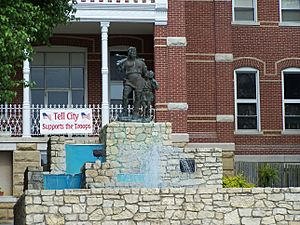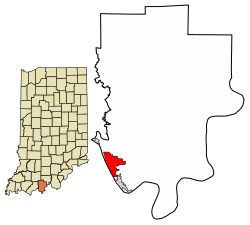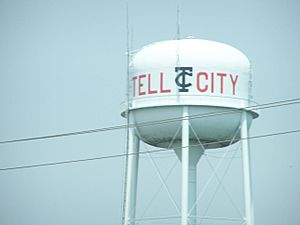Tell City, Indiana facts for kids
Quick facts for kids
Tell City, Indiana
|
|
|---|---|
| City of Tell City | |

A statue of William Tell and his son sits upon a fountain outside city hall. It is a famous city landmark.
|
|

Location of Tell City in Perry County, Indiana.
|
|
| Country | United States |
| State | Indiana |
| County | Perry |
| Township | Troy |
| Acquired | July 1857 |
| Founded | August 1858 |
| Area | |
| • Total | 4.65 sq mi (12.04 km2) |
| • Land | 4.53 sq mi (11.74 km2) |
| • Water | 0.12 sq mi (0.30 km2) 2.37% |
| Elevation | 417 ft (127 m) |
| Population
(2020)
|
|
| • Total | 7,506 |
| • Density | 1,655.49/sq mi (639.22/km2) |
| Time zone | UTC-6 (CST) |
| • Summer (DST) | UTC-5 (CDT) |
| ZIP code |
47586
|
| Area code(s) | 812 |
| FIPS code | 18-75248 |
| GNIS feature ID | 2396037 |
Tell City is a city in Perry County, Indiana. It is located along the Ohio River. In 2020, about 7,500 people lived there. Tell City is the main town, or county seat, of Perry County.
Contents
History of Tell City
Tell City began over 150 years ago. In 1856, a group of Swiss-German immigrants met in Cincinnati, Ohio. They formed a group called the "Swiss Colonization Society." Their goal was to find affordable homes for workers and farmers. They wanted to create a place where everyone could live together peacefully.
The Society decided to buy a large piece of land. They wanted a healthy climate, good soil, and plenty of water and trees. It also needed to be near a river for travel and trade. In July 1857, they bought a suitable area of about 4,152 acres. This land was then planned out with many town blocks and building lots.
Before people moved there, the new town needed a name. It was first called Helvetia. But soon, it was renamed Tell City. This name was easier for English speakers to say and remember. It honors William Tell, a famous Swiss hero.
The founders of Tell City were very thoughtful. They made sure the streets were wide. Many streets are named after famous people from history. These include leaders, artists, writers, and scientists. Some names are Jefferson, Mozart, and Franklin.
The Tell City post office has been open since 1858.
Schweizer Fest
In 1958, Tell City celebrated its 100th birthday. This event honored the first settlers and the city's founding. It was a big success! After that, the Tell City Historical Society started an annual festival. It is called Schweizer Fest, which means Swiss Fest. This festival is still held every year and is one of Indiana's oldest community festivals.
Plane Crash Memorial
On March 17, 1960, a plane called Northwest Orient Airlines Flight 710 crashed near Tell City. It was flying from Chicago to Miami. All 63 people on board died. A monument now stands there. It lists the names of those who died and the date of the tragedy.
Steamboat Tell City
A steamboat named Tell City was built in 1889. It was named after the city. This boat carried people and goods on the Ohio River. It sank on April 6, 1917. The boat's pilothouse, which is where the captain steers, survived. It is now the oldest steamboat pilothouse still existing. You can see it at the Ohio River Museum in Marietta, Ohio.
Geography and Climate
Tell City covers about 4.6 square miles. Most of this area is land, with a small part being water.
Climate in Tell City
Tell City has a varied climate. Summers are warm, and winters are cold. The city gets a good amount of rain throughout the year.
| Climate data for Tell City, Indiana (1991–2020 normals, extremes 1939–present) | |||||||||||||
|---|---|---|---|---|---|---|---|---|---|---|---|---|---|
| Month | Jan | Feb | Mar | Apr | May | Jun | Jul | Aug | Sep | Oct | Nov | Dec | Year |
| Record high °F (°C) | 79 (26) |
77 (25) |
88 (31) |
91 (33) |
96 (36) |
105 (41) |
105 (41) |
104 (40) |
106 (41) |
96 (36) |
86 (30) |
80 (27) |
106 (41) |
| Mean maximum °F (°C) | 63.3 (17.4) |
67.8 (19.9) |
74.9 (23.8) |
82.1 (27.8) |
87.5 (30.8) |
92.5 (33.6) |
94.1 (34.5) |
94.0 (34.4) |
92.0 (33.3) |
84.7 (29.3) |
74.0 (23.3) |
56.1 (13.4) |
95.8 (35.4) |
| Mean daily maximum °F (°C) | 40.5 (4.7) |
44.7 (7.1) |
54.2 (12.3) |
65.7 (18.7) |
74.4 (23.6) |
82.2 (27.9) |
85.3 (29.6) |
84.7 (29.3) |
79.2 (26.2) |
68.1 (20.1) |
54.9 (12.7) |
44.4 (6.9) |
64.9 (18.3) |
| Daily mean °F (°C) | 33.1 (0.6) |
36.5 (2.5) |
44.9 (7.2) |
55.3 (12.9) |
64.6 (18.1) |
72.9 (22.7) |
76.3 (24.6) |
75.2 (24.0) |
68.8 (20.4) |
57.6 (14.2) |
46.0 (7.8) |
37.3 (2.9) |
55.7 (13.2) |
| Mean daily minimum °F (°C) | 25.8 (−3.4) |
28.2 (−2.1) |
35.5 (1.9) |
44.9 (7.2) |
54.9 (12.7) |
63.6 (17.6) |
67.3 (19.6) |
65.7 (18.7) |
58.4 (14.7) |
47.0 (8.3) |
37.1 (2.8) |
30.1 (−1.1) |
46.5 (8.1) |
| Mean minimum °F (°C) | 9.2 (−12.7) |
12.7 (−10.7) |
21.5 (−5.8) |
31.8 (−0.1) |
41.8 (5.4) |
53.3 (11.8) |
59.8 (15.4) |
58.0 (14.4) |
46.2 (7.9) |
34.3 (1.3) |
24.7 (−4.1) |
15.9 (−8.9) |
6.4 (−14.2) |
| Record low °F (°C) | −17 (−27) |
−8 (−22) |
−1 (−18) |
20 (−7) |
30 (−1) |
42 (6) |
47 (8) |
46 (8) |
31 (−1) |
21 (−6) |
0 (−18) |
−14 (−26) |
−17 (−27) |
| Average precipitation inches (mm) | 3.70 (94) |
3.49 (89) |
4.74 (120) |
5.30 (135) |
5.82 (148) |
5.05 (128) |
4.12 (105) |
3.01 (76) |
3.71 (94) |
3.93 (100) |
3.93 (100) |
4.48 (114) |
51.28 (1,303) |
| Average precipitation days (≥ 0.01 in) | 9.2 | 8.3 | 10.2 | 10.6 | 11.4 | 9.3 | 8.5 | 7.1 | 6.9 | 7.4 | 8.2 | 10.6 | 107.7 |
| Source: NOAA | |||||||||||||
People of Tell City
| Historical population | |||
|---|---|---|---|
| Census | Pop. | %± | |
| 1860 | 1,030 | — | |
| 1870 | 1,660 | 61.2% | |
| 1880 | 2,112 | 27.2% | |
| 1890 | 2,094 | −0.9% | |
| 1900 | 2,680 | 28.0% | |
| 1910 | 3,369 | 25.7% | |
| 1920 | 4,086 | 21.3% | |
| 1930 | 4,873 | 19.3% | |
| 1940 | 5,395 | 10.7% | |
| 1950 | 5,735 | 6.3% | |
| 1960 | 6,609 | 15.2% | |
| 1970 | 7,933 | 20.0% | |
| 1980 | 8,704 | 9.7% | |
| 1990 | 8,088 | −7.1% | |
| 2000 | 7,845 | −3.0% | |
| 2010 | 7,272 | −7.3% | |
| 2020 | 7,506 | 3.2% | |
| U.S. Decennial Census | |||
In 2010, Tell City had 7,272 people. There were 3,224 households. Most residents (97.5%) were White. About 28% of households had children under 18. The average age in the city was 42 years old.
Education in Tell City
Tell City has its own high school, Tell City High School. Their sports teams are called the Marksmen. The city also has William Tell Elementary school.
Tell City has a public library. It is a part of the Perry County Public Library system.
Famous People from Tell City
Many notable people have come from Tell City, including:
- Krista Blunk - a former college basketball star
- Wally Bruner - an American journalist and TV host
- Ray Eddy - a former college basketball coach for the Purdue Boilermakers
- Paul D. Etienne - the Sixth Archbishop of Seattle
- Tom Kron - a former college and professional basketball star
- Bob Lochmueller - a former NBA player and basketball coach
- Edwin D. Patrick - a commander in the 6th Infantry Division during World War II
- Bob Polk - a former college basketball coach
- Burke Scott - a former college basketball player and U.S. Army Officer
See also
 In Spanish: Tell City (Indiana) para niños
In Spanish: Tell City (Indiana) para niños


